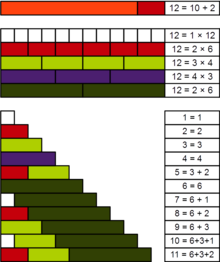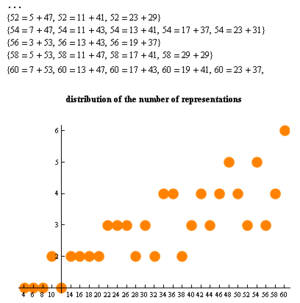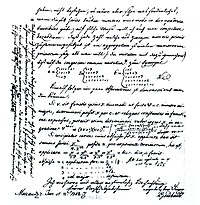Demonstration of the practicality of the number 12
In number theory, a practical number or panarithmic number is a positive integer n such that all smaller positive integers can be represented as sums of distinct divisors of n. For example, 12 is a practical number because all the numbers from 1 to 11 can be expressed as sums of its divisors 1, 2, 3, 4, and 6: as well as these divisors themselves, we have 5 = 3 + 2, 7 = 6 + 1, 8 = 6 + 2, 9 = 6 + 3, 10 = 6 + 3 + 1, and 11 = 6 + 3 + 2.
The sequence of practical numbers (sequence A005153 in the OEIS) begins
- 1, 2, 4, 6, 8, 12, 16, 18, 20, 24, 28, 30, 32, 36, 40, 42, 48, 54, 56, 60, 64, 66, 72, 78, 80, 84, 88, 90, 96, 100, 104, 108, 112, 120, 126, 128, 132, 140, 144, 150....
The name "practical number" is due to Srinivasan (1948). He noted that "the subdivisions of money, weights, and measures involve numbers like 4, 12, 16, 20 and 28 which are usually supposed to be so inconvenient as to deserve replacement by powers of 10." He rediscovered the number theoretical property of such numbers and was the first to attempt a classification of these numbers that was completed by Stewart (1954) and Sierpiński (1955). This characterization makes it possible to determine whether a number is practical by examining its prime factorization. Every even perfect number and every power of two is also a practical number.
Practical numbers have also been shown to be analogous with prime numbers in many of their properties.
Characterization of practical numbers
The original characterisation by Srinivasan (1948) stated that a practical number cannot be a deficient number, that is one of which the sum of all divisors (including 1 and itself) is less than twice the number unless the deficiency is one. If the ordered set of all divisors of the practical number is
is  with
with  and
and  , then Srinivasan's statement can be expressed by the inequality
, then Srinivasan's statement can be expressed by the inequality
.
 of a practical number has to be a complete sub-sequence.
of a practical number has to be a complete sub-sequence.This partial characterization was extended and completed by Stewart (1954) and Sierpiński (1955) who showed that it is straightforward to determine whether a number is practical from its prime factorization. A positive integer greater than one with prime factorization
 (with the primes in sorted order
(with the primes in sorted order  ) is practical if and only if each of its prime factors
) is practical if and only if each of its prime factors  is small enough for
is small enough for  to have a representation as a sum of smaller divisors. For this to be true, the first prime
to have a representation as a sum of smaller divisors. For this to be true, the first prime  must equal 2 and, for every i from 2 to k, each successive prime
must equal 2 and, for every i from 2 to k, each successive prime  must obey the inequality
must obey the inequality
 denotes the sum of the divisors of x. For example, 2 × 32
× 29 × 823 = 429606 is practical, because the inequality above holds
for each of its prime factors: 3 ≤ σ(2) + 1 = 4, 29 ≤ σ(2 × 32) + 1 = 40, and 823 ≤ σ(2 × 32 × 29) + 1 = 1171.
denotes the sum of the divisors of x. For example, 2 × 32
× 29 × 823 = 429606 is practical, because the inequality above holds
for each of its prime factors: 3 ≤ σ(2) + 1 = 4, 29 ≤ σ(2 × 32) + 1 = 40, and 823 ≤ σ(2 × 32 × 29) + 1 = 1171.The condition stated above is necessary and sufficient for a number to be practical. In one direction, this condition is necessary in order to be able to represent
 as a sum of divisors of n,
because if the inequality failed to be true then even adding together
all the smaller divisors would give a sum too small to reach
as a sum of divisors of n,
because if the inequality failed to be true then even adding together
all the smaller divisors would give a sum too small to reach  . In the other direction, the condition is sufficient, as can be shown by induction.
More strongly, if the factorization of n satisfies the condition above, then any
. In the other direction, the condition is sufficient, as can be shown by induction.
More strongly, if the factorization of n satisfies the condition above, then any  can be represented as a sum of divisors of n, by the following sequence of steps:
can be represented as a sum of divisors of n, by the following sequence of steps:
- Let
, and let
.
- Since
and
can be shown by induction to be practical, we can find a representation of q as a sum of divisors of
.
- Since
, and since
can be shown by induction to be practical, we can find a representation of r as a sum of divisors of
.
- The divisors representing r, together with
times each of the divisors representing q, together form a representation of m as a sum of divisors of n.
Properties
- The only odd practical number is 1, because if n > 2 is an odd number, then 2 cannot be expressed as the sum of distinct divisors of n. More strongly, Srinivasan (1948) observes that other than 1 and 2, every practical number is divisible by 4 or 6 (or both).
- The product of two practical numbers is also a practical number. More strongly the least common multiple of any two practical numbers is also a practical number. Equivalently, the set of all practical numbers is closed under multiplication.
- From the above characterization by Stewart and Sierpiński it can be seen that if n is a practical number and d is one of its divisors then n*d must also be a practical number.
- In the set of all practical numbers there is a primitive set of practical numbers. A primitive practical number is either practical and squarefree or practical and when divided by any of its prime factors whose factorization exponent is greater than 1 is no longer practical. The sequence of primitive practical numbers (sequence A267124 in the OEIS) begins
-
- 1, 2, 6, 20, 28, 30, 42, 66, 78, 88, 104, 140, 204, 210, 220, 228, 260, 272, 276, 304, 306, 308, 330, 340, 342, 348, 364, 368, 380, 390, 414, 460 ...
Relation to other classes of numbers
Several other notable sets of integers consist only of practical numbers:- From the above properties with n a practical number and d one of its divisors (that is, d | n) then n*d must also be a practical number therefore six times every power of 3 must be a practical number as well as six times every power of 2.
- Every power of two is a practical number. Powers of two trivially satisfy the characterization of practical numbers in terms of their prime factorizations: the only prime in their factorizations, p1, equals two as required.
- Every even perfect number is also a practical number. This follows from Leonhard Euler's result that an even perfect number must have the form 2n − 1(2n − 1). The odd part of this factorization equals the sum of the divisors of the even part, so every odd prime factor of such a number must be at most the sum of the divisors of the even part of the number. Therefore, this number must satisfy the characterization of practical numbers.
- Every primorial (the product of the first i primes, for some i) is practical. For the first two primorials, two and six, this is clear. Each successive primorial is formed by multiplying a prime number pi by a smaller primorial that is divisible by both two and the next smaller prime, pi − 1. By Bertrand's postulate, pi < 2pi − 1, so each successive prime factor in the primorial is less than one of the divisors of the previous primorial. By induction, it follows that every primorial satisfies the characterization of practical numbers. Because a primorial is, by definition, squarefree it is also a primitive practical number.
- Generalizing the primorials, any number that is the product of nonzero powers of the first k primes must also be practical. This includes Ramanujan's highly composite numbers (numbers with more divisors than any smaller positive integer) as well as the factorial numbers.
Practical numbers and Egyptian fractions
If n is practical, then any rational number of the form m/n with m < n may be represented as a sum ∑di/n where each di is a distinct divisor of n. Each term in this sum simplifies to a unit fraction, so such a sum provides a representation of m/n as an Egyptian fraction. For instance,Vose (1985) showed that every number x/y has an Egyptian fraction representation with
 terms. The proof involves finding a sequence of practical numbers ni with the property that every number less than ni may be written as a sum of
terms. The proof involves finding a sequence of practical numbers ni with the property that every number less than ni may be written as a sum of  distinct divisors of ni. Then, i is chosen so that ni − 1 < y ≤ ni, and xni is divided by y giving quotient q and remainder r. It follows from these choices that
distinct divisors of ni. Then, i is chosen so that ni − 1 < y ≤ ni, and xni is divided by y giving quotient q and remainder r. It follows from these choices that  . Expanding both numerators on the right hand side of this formula into sums of divisors of ni results in the desired Egyptian fraction representation. Tenenbaum & Yokota (1990) use a similar technique involving a different sequence of practical numbers to show that every number x/y has an Egyptian fraction representation in which the largest denominator is
. Expanding both numerators on the right hand side of this formula into sums of divisors of ni results in the desired Egyptian fraction representation. Tenenbaum & Yokota (1990) use a similar technique involving a different sequence of practical numbers to show that every number x/y has an Egyptian fraction representation in which the largest denominator is  .
.
According to a September 2015 conjecture by Zhi-Wei Sun, every positive rational number has an Egyptian fraction representation in which every denominator is a practical number. There is a proof for the conjecture on David Eppstein's blog.
Analogies with prime numbers
One reason for interest in practical numbers is that many of their properties are similar to properties of the prime numbers. Indeed, theorems analogous to Goldbach's conjecture and the twin prime conjecture are known for practical numbers: every positive even integer is the sum of two practical numbers, and there exist infinitely many triples of practical numbers x − 2, x, x + 2. Melfi also showed that there are infinitely many practical Fibonacci numbers (sequence A124105 in the OEIS); the analogous question of the existence of infinitely many Fibonacci primes is open. Hausman & Shapiro (1984) showed that there always exists a practical number in the interval [x2,(x + 1)2] for any positive real x, a result analogous to Legendre's conjecture for primes.Let p(x) count how many practical numbers are at most x. Margenstern (1991) conjectured that p(x) is asymptotic to cx/log x for some constant c, a formula which resembles the prime number theorem, strengthening the earlier claim of Erdős & Loxton (1979) that the practical numbers have density zero in the integers. Saias (1997) proved that for suitable constants c1 and c2:
 and some constant
and some constant  .
.











![1{\big /}{\big [}\ln m\,\ln(n-m){\big ]}](https://wikimedia.org/api/rest_v1/media/math/render/svg/ebd3400044de44f8fc6c9c4a5830d94c5719a92d)











